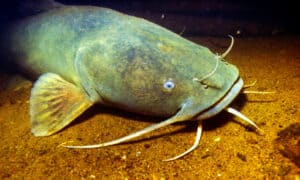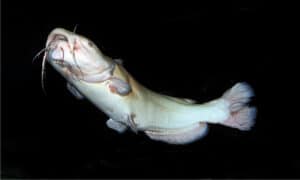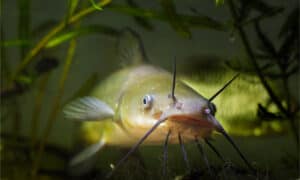Blue catfish are not your average fish; they’re genuine heavyweights in the world of freshwater fishing.
Picture a fish so large it could rival a small child in size. Imagine a creature so robust it thrives in a range of water conditions, making its home from clear lakes to muddy river bottoms. That’s the blue catfish for you — a behemoth of the deep, a true testament to nature’s marvels.
But let’s focus our attention on one specific place where these giants really shine — Louisiana. This state, with its vast network of waterways, is like a paradise for the blue catfish. From the mighty Mississippi River to the labyrinthine waters of the Atchafalaya River Basin, blue catfish in Louisiana are living large and making waves.
In this article, we discover the largest blue catfish ever caught in Louisiana.
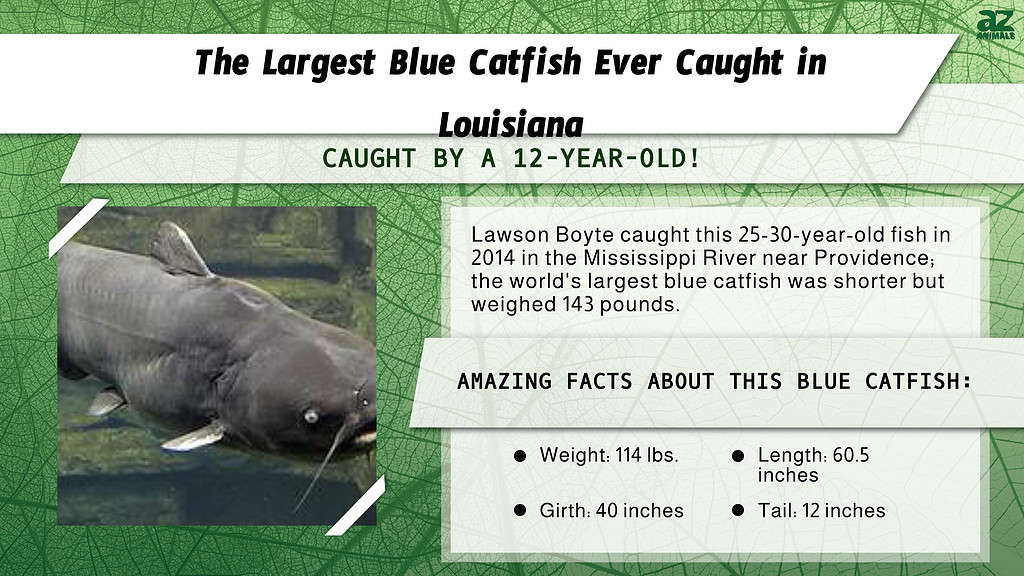
The life of blue catfish isn’t all smooth sailing. They face a few challenges, too, from environmental changes to human activities. Here, we will also plunge into the exciting, somewhat murky, yet incredibly captivating world of blue catfish in Louisiana. So, buckle up as we dive deeper into the fascinating world of blue catfish in the vibrant waterways of Louisiana!
The Largest Blue Catfish Ever Caught in Louisiana
The largest blue catfish ever caught in Louisiana weighed an impressive 114 pounds, was 60.5 inches long, had a girth of 40 inches, and had a 12-inch tail. Twelve-year-old Lawson Boyte caught the fish in the Mississippi River in March 2014 while fishing with his uncle and cousin. A local Wildlife and Fisheries biologist estimated the fish to be 25-30 years old.
The Largest Blue Catfish Ever Caught Worldwide
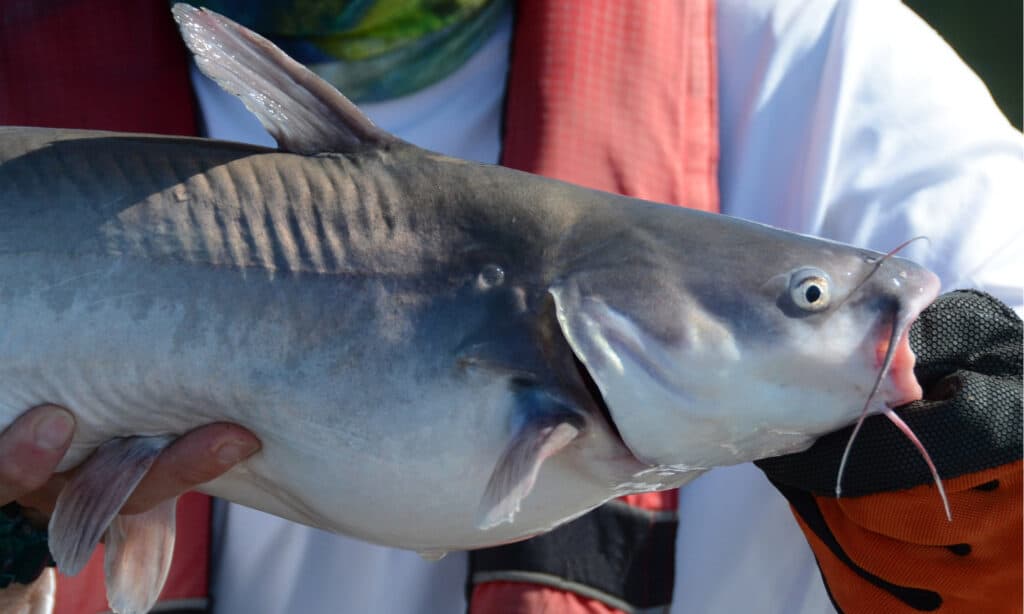
Blue catfish are commonly found in the 2-foot range weighing 20-40 pounds.
©M Huston/Shutterstock.com
The largest blue catfish ever caught worldwide weighed an astounding 143 pounds. Angler Richard Anderson caught the enormous catfish at Kerr Lake on the border of Virginia and North Carolina in 2011. Beyond its astonishing weight, this record blue catfish boasted a length of 57 inches (shorter than the Louisiana catch) and a girth of 44 inches. Anderson managed to reel in this behemoth using his reliable Shakespeare Ugly Stik which was equipped with a Daiwa reel.
The Blue Catfish Species
Say hello to the blue catfish, an aquatic powerhouse that’s causing a stir in fishing circles. This marvelous species commands attention, boasting a suite of features that make it stand out in the underwater realm.
Spotting a Blue Catfish
Let’s start with appearances. The blue catfish is no run-of-the-mill species. Its smooth, scale-less skin displays a silvery-blue to gray color, providing excellent camouflage in the watery depths. In addition, it has a distinctly forked tail — a signature trait of this species. But perhaps its most distinctive feature is its sharp, whisker-like barbels around its mouth. These serve as superb sensory organs, enabling the fish to locate food even in the darkest and murkiest environments.
And if you think that these creatures are tiny, think again! Blue catfish are genuine heavyweights, growing to over 100 pounds and several feet in length. Imagine reeling in a catch that size!
Home Is Where the Water’s Deep
When it comes to home preferences, blue catfish are clear about what they like. They’re at home in large rivers and reservoirs with deep, slow-moving waters. The sandy or muddy bottoms of these water bodies are their favorite hangouts, providing a comfortable environment where they can search for food at leisure.
Nighttime Hunters
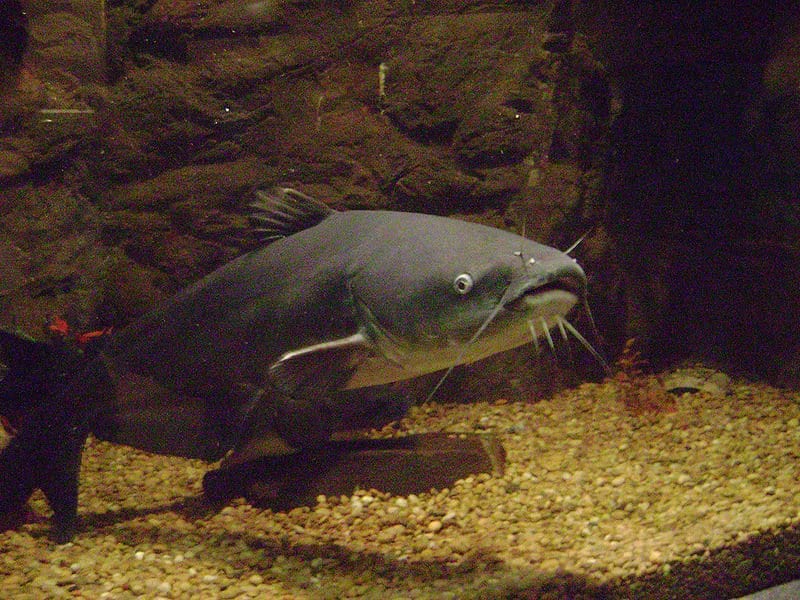
Blue catfish prefer to hunt at night using their barbels.
©Billy Ogle/Flickr – License
Talking about behavior, blue catfish are creatures of the night. They’re essentially nocturnal, preferring to do their hunting under the cover of darkness. However, with their barbels acting as state-of-the-art sensors, they can pick up on the slightest movement or smell, helping them locate their prey in even the murkiest waters.
The Long and Short of Lifespan and Growth
Blue catfish aren’t just sizeable; they’re also notable for their longevity. Under optimal conditions, they can live up to 20 years, sometimes even longer. Their growth rate is equally noteworthy. Young ‘blues’ are quick to bulk up, with some reaching a weighty 30 pounds within their first few years.
Blue Catfish in Louisiana
Welcome to Louisiana, a state famous for its rich culture, spicy cuisine, and, you guessed it—blue catfish! Let’s dive into the murky waters and discover how this charming state became a hotspot for these impressive swimmers.
A Growing Population
First off, let’s talk numbers. Louisiana is home to a thriving blue catfish population, thanks to its numerous water bodies that provide the perfect habitat. The state’s rivers, lakes, and reservoirs teem with these giant fish, making Louisiana a prime spot for blue catfish enthusiasts.
Waterways that Welcome
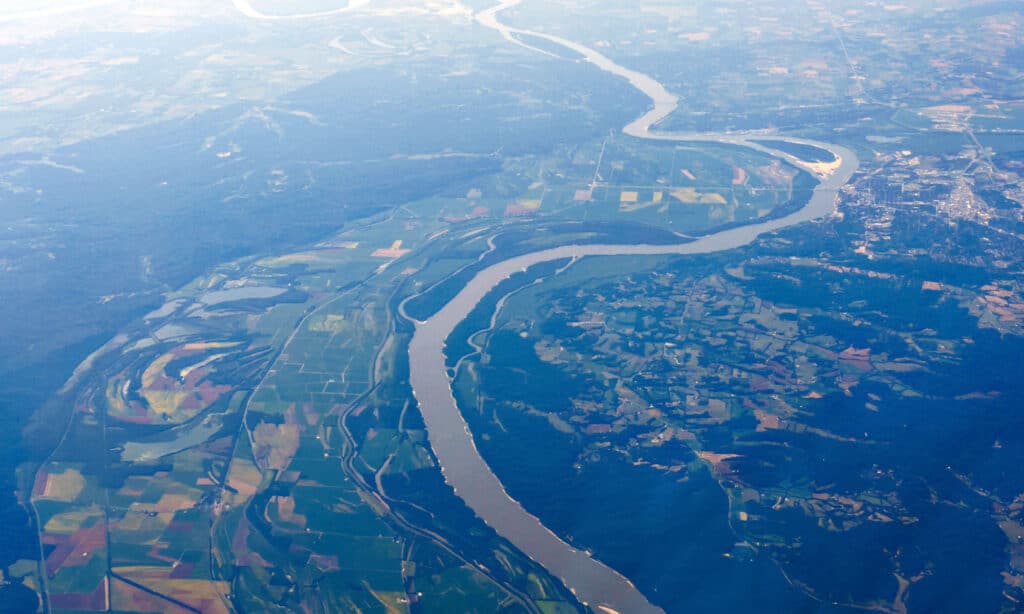
At its deepest point, the Mississippi River can reach 200 feet!
©RaksyBH/Shutterstock.com
The blue catfish have found a haven in Louisiana’s extensive waterways. Notable hotspots include the Mississippi River and the Atchafalaya River Basin. These vast, slow-moving bodies of water, coupled with their deep channels and plentiful food supply, provide the ideal environment for the blue catfish to grow and prosper.
Environment and Its Influence
Louisiana’s environment is something of a wonder for blue catfish. The state’s warm, humid climate, combined with its rich, nutrient-laden waters, has led to a surge in the blue catfish population. These conditions support a diverse food chain, ensuring that the blue catfish have a plentiful supply of their favorite meals.
From Fry to Giants
In Louisiana, blue catfish have the room and resources to grow to their full potential. Given the right conditions, these fish can grow significantly in just a few years, contributing to the population of giant blues that roam the state’s waterways. As a result, it’s not uncommon to hear of anglers reeling in a blue catfish that’s over 50 pounds in these parts!
Diet of Blue Catfish
Ready to learn what keeps the tank-like blue catfish going? Let’s delve into the nitty-gritty of their feeding habits. Fair warning—these robust creatures have quite an appetite!
Seafood
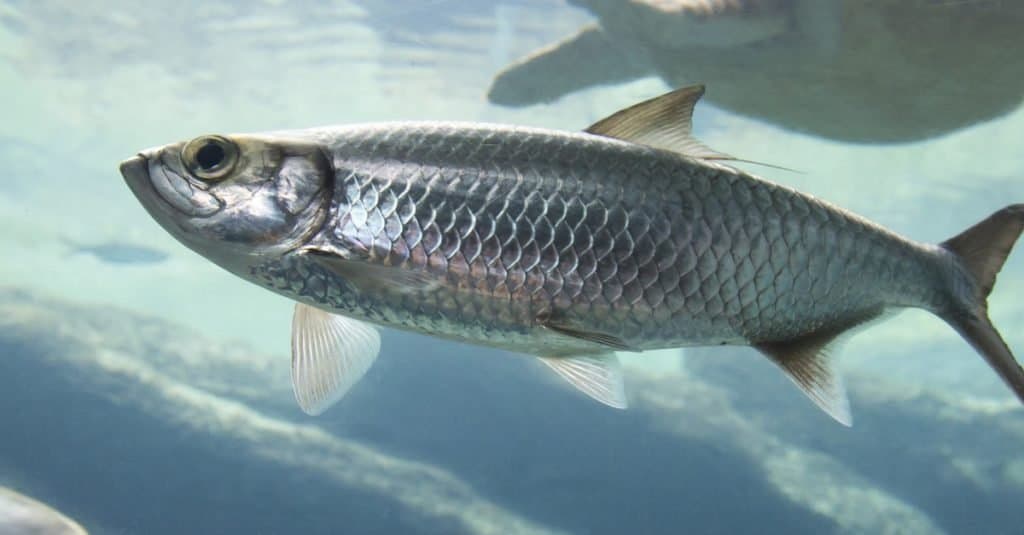
Herring is a common meal for blue catfish.
©Four Oaks/Shutterstock.com
Blue catfish have an expansive diet. They’re opportunistic feeders, gobbling up whatever comes their way. Smaller fish such as shad and herring, various types of crustaceans, worms, and even plant matter are all fair game for these insatiable eaters. There’s not much they’ll turn their noses up at—or rather, their whiskers!
Effects on Growth and Behavioral Traits
The impact of the blue catfish’s varied diet on their growth is immense. The high-protein meals, particularly the smaller fish and crustaceans they consume, contribute significantly to their rapid growth rate. Within just a few years, these young blues can morph into real river monsters, often reaching impressive weights.
But the effect of their diet isn’t just about size—it also influences their behavior. Their broad diet pushes them to explore different parts of their aquatic habitat. They scour the sandy bottoms, venture into deep waters, and sometimes, they even prowl near the surface, all in search of a good meal.
The Ripple Effect on the Food Chain
The feeding habits of the blue catfish have a substantial ripple effect on the aquatic ecosystem. On one hand, they’re a vital link in the food chain. But on the other hand, they help control the population of other species, maintaining the balance in their watery habitat.
However, their hearty appetite can cause complications. If the blue catfish population becomes too large, they can overfeed on certain species, causing a disruption in the ecological balance. This underlines the importance of effective fishery management to maintain a healthy environment for all species.
Predators of Blue Catfish
While the blue catfish may be a powerhouse in its own right, it’s not always at the top of the food chain. So let’s delve into the details of what creatures pose a threat to these underwater heavyweights.
Nature’s Law Applies
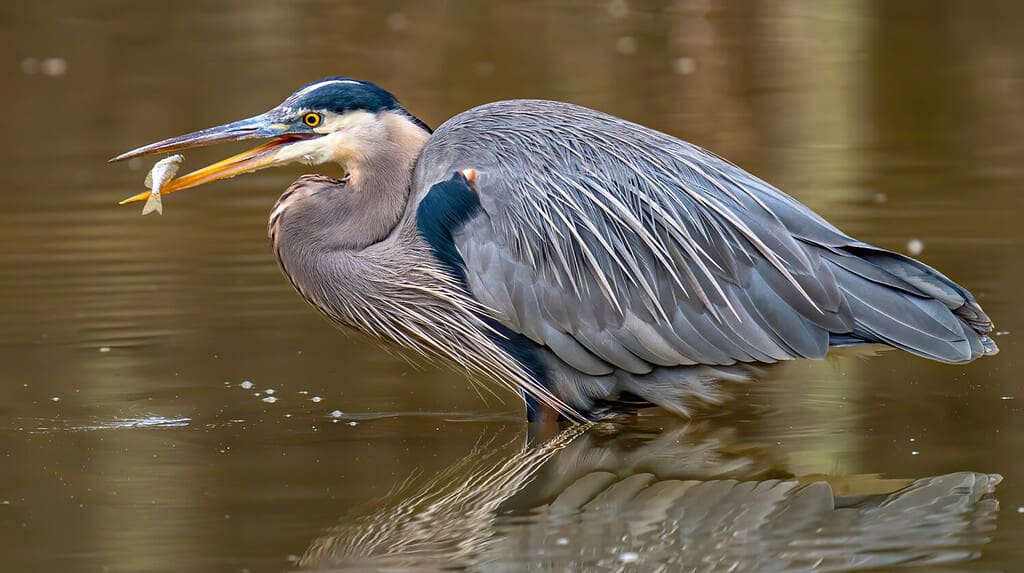
Great blue herons can eat up to two pounds of fish per day.
©Krumpelman Photography/Shutterstock.com
Despite their size and might, blue catfish aren’t exempt from nature’s law—every creature has a predator. When they’re young and small, blue catfish are easy pickings for larger fish such as bass, larger catfish, and even predatory birds like herons and eagles that are keen-eyed enough to spot a meal beneath the water’s surface.
Size Doesn’t Always Matter
As blue catfish grow, their list of predators shrinks, but that doesn’t mean they’re out of danger. Alligators, found in abundance in Louisiana’s waterways, take on full-sized blue catfish. Even humans can be considered predators, with anglers seeking out blue catfish for sport and sustenance.
Effects on Population Dynamics
Predators play a vital role in controlling the blue catfish population, preventing it from spiraling out of control and causing an imbalance in the ecosystem. Their role is crucial in ensuring that blue catfish numbers stay in check, maintaining a harmonious balance within their aquatic habitats.
However, a disruption in the natural predator-prey balance can have significant repercussions. For example, if predator numbers dwindle, blue catfish populations could explode, leading to potential overfeeding and disruption of other species. Conversely, if too many blue catfish are consumed, it could lead to a decline in their population, which also disrupts the food chain.
Threats to Blue Catfish in Louisiana
Even though blue catfish are robust and resilient, they face a myriad of threats in their aquatic homes in Louisiana. Let’s dive deeper into these challenges and how they affect these impressive fish.
The Human Factor
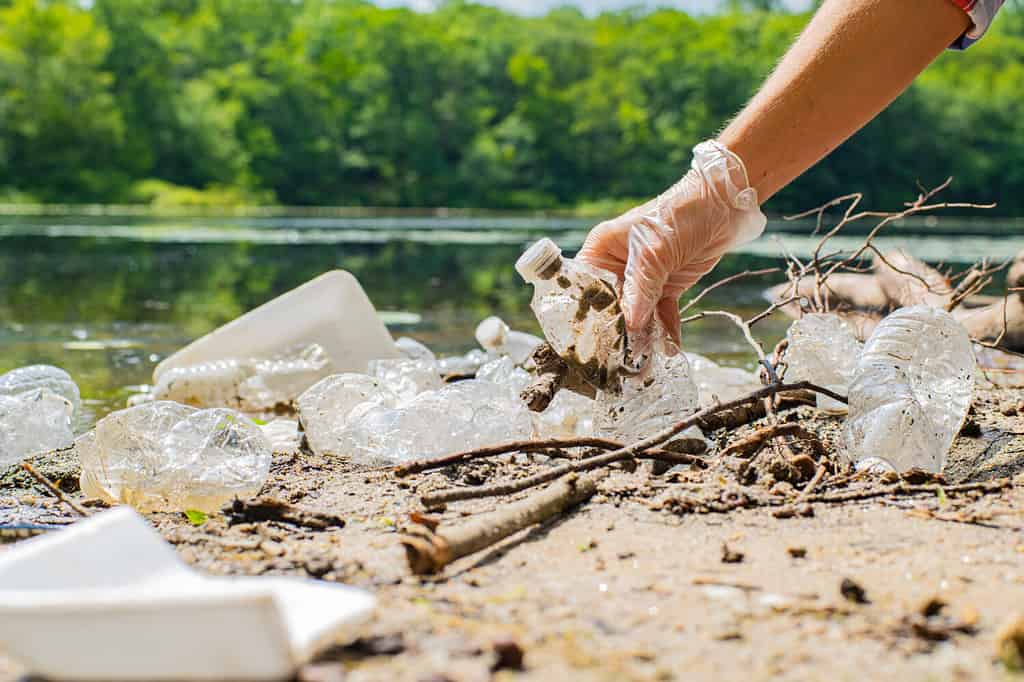
Water pollution is greatly affecting the blue catfish population, as well as many others.
©Dmytro Flisak/Shutterstock.com
Unquestionably, human activities pose one of the most significant threats to blue catfish in Louisiana. First, of course, overfishing is a primary concern. Commercial fishing, recreational angling, and fishing for sustenance can deplete their numbers rapidly if not managed sustainably. But the human impact doesn’t stop there.
Habitat destruction due to urban development, deforestation, and the construction of dams can lead to the loss of breeding grounds and disrupt their natural habitats. Similarly, water pollution from industrial waste, agricultural runoff, and litter can degrade the water quality, affecting the health and survival of these fish.
Fluctuations in Water Conditions
Water is the lifeblood of the blue catfish, and changes in its conditions can impact them significantly. Fluctuations in temperature, variations in water levels due to seasonal changes or human intervention, and shifts in the salinity of the water can all stress the blue catfish, affecting their growth, reproduction, and overall survival.
Pollution can also introduce toxins into the water, which can accumulate in the bodies of blue catfish, affecting their health and reducing their lifespan.
Natural Predators and Competing Species
The wild is a complex web of interactions, and blue catfish are part of this intricate network. For example, natural predators can influence their numbers significantly. Also, competition for resources can pose a threat. Other fish species may vie for the same food sources or habitats, putting additional pressure on the blue catfish.
The Shadow of Climate Change
The overarching shadow of climate change looms large over blue catfish. Warming water temperatures can alter their habitats, disrupting their feeding and breeding patterns. In addition, an increased frequency of extreme weather events, such as hurricanes and floods, can lead to sudden and drastic changes in their habitats.
Moreover, changes in water chemistry, particularly the increased acidification of water bodies due to higher levels of carbon dioxide, can impact the health and reproductive success of blue catfish.
Fishing for Blue Catfish in Louisiana
So, you’re intrigued by the world of blue catfish fishing? Well, Louisiana is just the place for you! So, let’s dive into the exciting and challenging realm of angling for these underwater giants.
A Sport Loved by Many
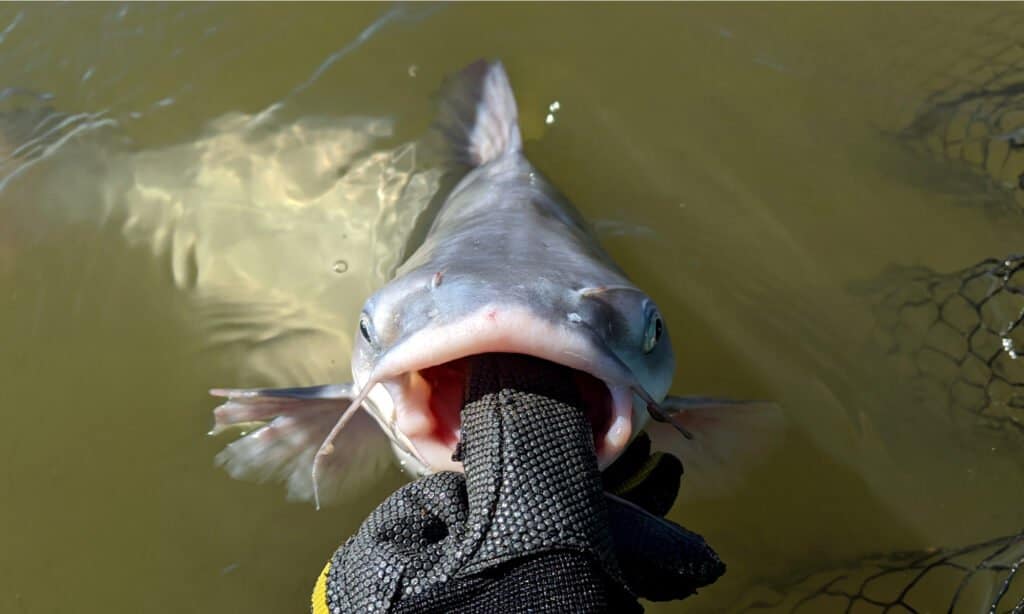
Fishing for blue catfish is a beloved pastime in Louisana.
©M Huston/Shutterstock.com
Fishing for blue catfish in Louisiana is more than just a pastime; it’s a beloved sport that attracts enthusiasts from far and wide. From the thrill of the first bite to the struggle of reeling in a hefty blue, it’s an adrenaline-packed adventure that’s hard to match. But this isn’t a sport for the faint-hearted—you’ll need strength, patience, and the right techniques to land one of these bad boys!
Techniques and Tactics
Fishing for blue catfish demands a unique set of skills. Seasoned anglers often use techniques like bottom fishing, drift fishing, or jug fishing to increase their chances of a catch. Choosing the right bait is also important—remember, these creatures are opportunistic feeders! Common choices include cut bait, live bait, or specially designed catfish dough baits.
The Ideal Spots
When fishing for blue catfish in Louisiana, location is key. Hotspots include the Mississippi River and the Atchafalaya River Basin, which have high catfish populations. Other promising locations include the many lakes, reservoirs, and bayous that dot the state.
Rules and Regulations
Even in the thrill of the chase, it’s essential to remember the rules and regulations. Louisiana has fishing regulations in place to ensure the sustainable management of fish species, including blue catfish. These include:
- Size and bag limits
- Gear restrictions
- Specific fishing seasons
So, before you cast your line, make sure you’re well-versed in the rules.
Key Takeaways
We’ve swum through the ins and outs of the remarkable world of blue catfish in Louisiana. From understanding their biology and behavior to appreciating their value to the local economy, we’ve covered a lot of water.
These aquatic giants are more than just an angler’s dream. They are integral to the Louisiana ecosystem and crucial players in its aquatic food web. They’re an economic boon, too, supporting recreational and commercial fishing and even driving eco-tourism.
But let’s not forget, our finned friends face their share of threats. From changes in water conditions to human activities, they navigate a sea of challenges every day. So it’s on us to ensure we’re fishing responsibly, following regulations, and doing our part to conserve their habitats.
The photo featured at the top of this post is © Thomsonmg2000, cropped and adjusted by Kostka Martin / CC0 – License / Original
Thank you for reading! Have some feedback for us? Contact the AZ Animals editorial team.



